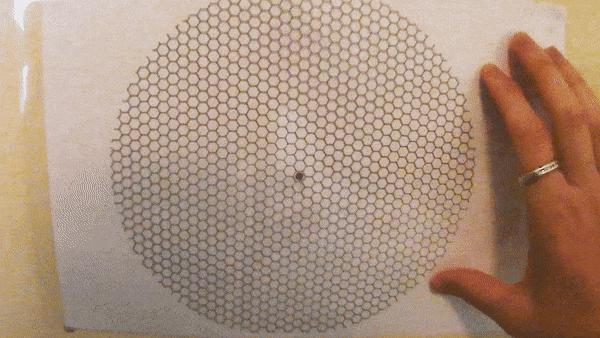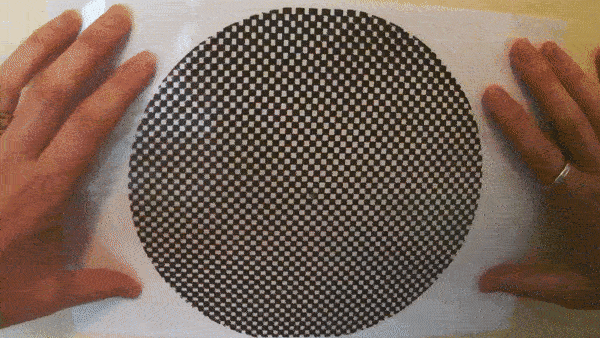 A recent FLEET homescience exercise explained how simple geometric patterns printed on transparency (‘overhead projector sheets’, to those of us old enough to remember such technology), and overlaid at varying angles, produced a combined ‘Moire’ pattern of varying dimensions.
A recent FLEET homescience exercise explained how simple geometric patterns printed on transparency (‘overhead projector sheets’, to those of us old enough to remember such technology), and overlaid at varying angles, produced a combined ‘Moire’ pattern of varying dimensions.
Two sheets of repeating squares produces a Moire pattern of larger squares. Two sheets of repeating triangles produces a Moire pattern of larger triangles.
And two sheets of repeating hexagons produces a Moire pattern of larger hexagons (see image).
This last exercise is interesting because it reflects exactly what happens with twisted bi-layer graphene.
 Recently it was discovered that superconductivity could be produced in a pair of stacked graphene layers that were rotated to the ‘magic twist angle’ of 1.1 degrees.
Recently it was discovered that superconductivity could be produced in a pair of stacked graphene layers that were rotated to the ‘magic twist angle’ of 1.1 degrees.
In this stacked, misaligned configuration, electrons flow with no resistance, while separately, each of the two graphene layers shows no special electrical properties.
The discovery has shown how the careful control of rotational symmetries can unveil unexpected material responses.
FLEET Director Prof Michael Fuhrer explains:
When you twist the two layers you get a Moire pattern which is hexagonal, but has a larger lattice constant than graphene itself (like this).
The new hexagonal lattice is like a super-graphene with larger lattice constant. The velocity is inversely proportional to the lattice constant, so the electrons slow down*. As a result, they feel each other more strongly (the potential energy of the Coulomb interaction of the electrons becomes large compared to their kinetic energy). In such strongly interacting systems the electrons can spontaneously lower their energy by forming a new insulating state. This insulator differs from a regular insulator in that it isn’t predicted from band theory if you consider the properties of just one electron – you need to consider the interactions. In twisted graphene the new insulating state tends to occur when there are an integer number of electrons on each site in the Moire lattice. If you add a few extra electrons (or take a few away), you get metallic behaviour again, but also superconductivity. The reason this is exciting is that the same thing happens in the high-Tc superconductors (Tc is transition temperature for superconductivity) which have copper oxide as a constituent – these materials are interaction-induced insulators, but become metallic when you add extra electrons (or take them away) and superconduct at very high temperatures.
At the moment, the superconducting transition temperatures in twisted graphene aren’t very high, around 1 Kelvin. But all of the energy scales in twisted graphene are very small, and 1 K actually is surprisingly high given how small all the other energies are. So there’s some hope that if we can understand why twisted graphene superconducts we could design new high-Tc superconductors.
*It turns out that not only do the electrons slow down, Allan MacDonald predicted that there’s a “magic angle” of twist where the velocity goes to zero. So, near this magic angle, the interaction effects are very large. This is why you’ll hear the phrase “magic angle twisted graphene” or the like to describe these systems. “
Novel electronic properties in ‘misaligned’ graphene sheets was first predicted by NUS Professor (and FLEET Partner Investigator) Antonio Castro Neto in 2007, and the ‘magic angle’ of 1.1 degrees was theorised by FLEET PI Allan MacDonald (University of Texas in Austin) in 2011.
Superconductivity in twisted graphene was experimentally demonstrated by Pablo Jarillo-Herrero (MIT) in 2018.
FLEET researchers are part of an international collaboration applying ‘twistronics’ concepts (the science of layering and twisting 2D materials to control their electrical properties) to manipulate the flow of light in extreme ways.



